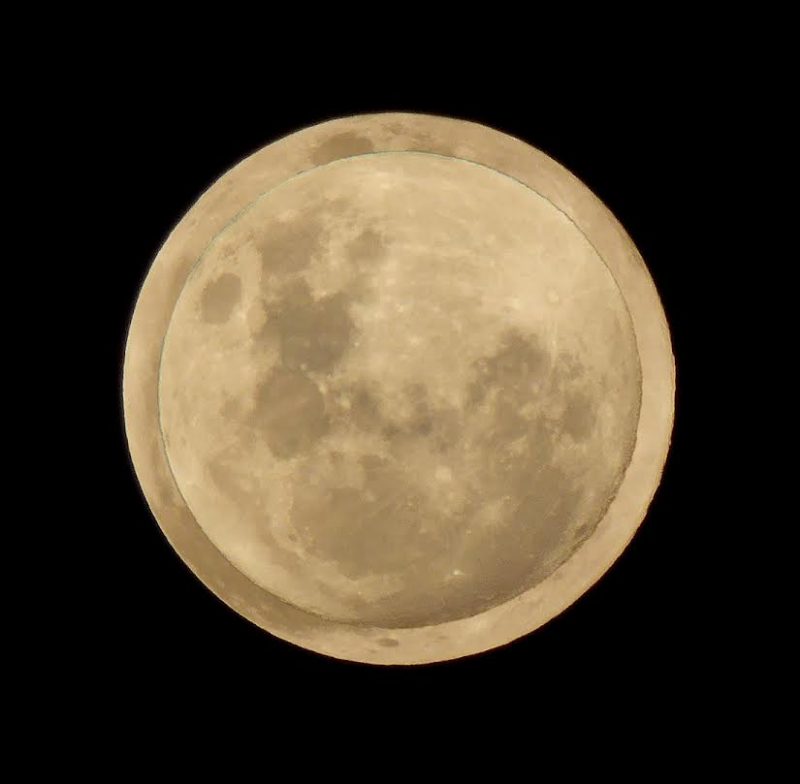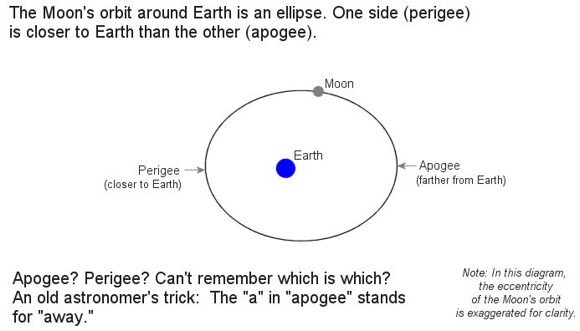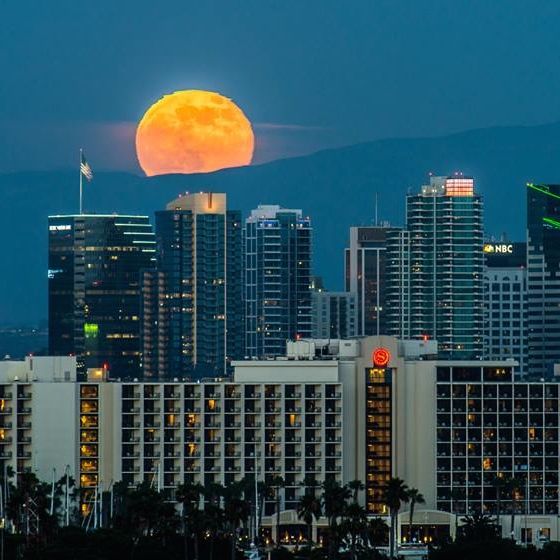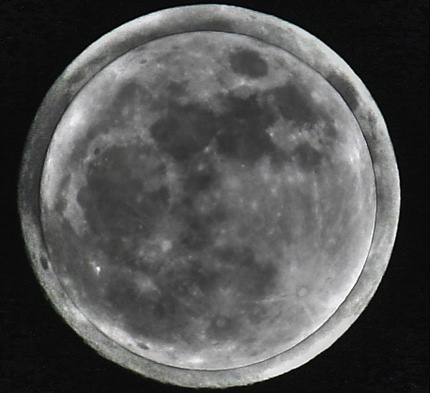
Above image by Peter Lowenstein contrasts apparent sizes of full supermoon with full micro-moon.
We know that the upcoming full moon on September 16, 2016 will be the Northern Hemisphere’s Harvest Moon. We also know that this full moon will pass through the Earth’s penumbral shadow, to display a faint penumbral eclipse seen from the world’s Eastern Hemisphere. However, it is less than clear as to whether the September 2016 full moon should be dubbed a supermoon.
An astrologer, Richard Nolle, is credited for coining the term supermoon, which has now become so widely used. He defines a supermoon as:
… a new or full moon which occurs with the moon at or near (within 90% of) its closest approach to Earth in a given orbit.
Based on this definition, should the September 16, 2016 full moon be regarded as a supermoon? Nolle and a well known astronomer, Fred Espenak, seem to disagree. Follow the links below to learn more.
How many full moon supermoons in 2016? Commentators disagree
Original definition of supermoon
Nolle’s 90% based on 2016’s closest perigee and farthest apogee
Espenak’s 90% based on perigee and apogee of each month’s orbit
September full moon’s distance relative to 2016’s closest perigee / farthest apogee
Is the September 16 full moon a supermoon? Depends on which perigee/apogee distances you choose

How many full supermoons in 2016? Commentators disagree. Richard Nolle coined the term supermoon and supplied the original supermoon definition. Fred Espenak‘s career as a NASA astrophysicist at Goddard Space Flight Center spanned more than 30 years; he’s best known and loved as NASA’s eclipse expert (Mr. Eclipse).
The supermoon definition, as it stands, comes with some ambiguity. That’s why at least two commentators – and possibly, some more – may give different answers for the number of supermoons this year.
We refer you to two different supermoon tables for the 21st century (2001 to 2100). Here is Richard Nolle’s table, and here is Fred Espenak’s table.
Richard Nolle lists three full moons in a row as supermoons: October, November and December, 2016 full moons.
Meanwhile, Fred Espenak lists five full moons in a row as supermoons: September, October, November, and December, 2016 – plus the full moon on January 12, 2017. Nolle does not list the Janaury, 2017 full moon as a supermoon.
Why are their lists so different?

Original definition of supermoon. Supermoons are based on lunar perigee (moon’s closest point to Earth for the month) and apogee (moon’s farthest point from Earth for the month). Remember, Nolle originally defined a supermoon as:
… a new or full moon which occurs with the moon at or near (within 90% of) its closest approach to Earth in a given orbit.
Each month, the moon comes closest to Earth at perigee and swings farthest away at apogee. If a new or full moon aligns with apogee, then it’s at 0% of its closest approach to Earth. On the other hand, if a new or full moon aligns with perigee, then it’s at 100% of its closest approach to Earth. That’s something we can all agree on.
But the phrase 90% of perigee is ambiguous. Read on.

Nolle’s 90% is based on 2016’s closest perigee and farthest apogee. Looking at Richard Nolle’s list for all the supermoons in the 21st century, it appears that Richard Nolle bases his 90% figure on the year’s closest perigee and farthest apogee. Take the year 2016, for instance, whereby any new or full moon coming closer than 361,524.3 km qualifies as a supermoon.
This year, in 2016, the moon comes closest to Earth on November 14 (356,509 kilometers), and swings farthest away some two weeks before, on October 31 (406,662 kilometers). That’s a difference of 50,153 km (406,662 – 356,509 = 50,153 km). Ninety percent of this 50,153-figure equals 45,137.7 kilometers (0.9 x 50,153 = 45,137.7). Presumably, any new or full moon coming closer than 361,524.3 kilometers (406,662 – 45,137.7 = 361,524.3) would be “at or near (within 90% of) its closest approach to Earth.”
Farthest apogee (2016): 406,662 km
Closest perigee (2016): 356,509 km
Difference: 50,153 km
90% x 50,153 = 45,137.7 km
406,662 – 45,137.7 = 361,524.3 km = 90% of moon’s closest distance to Earth
Thus, figuring out “90% of the moon’s closest approach to Earth” by the year’s closest perigee and farthest apogee, any new or full moon swinging closer than 361,524.3 km to Earth in 2016 counts as a supermoon.
Since the full moon on September, 2016 only comes within 364,754 km of Earth, it doesn’t count as a supermoon on Richard Nolle’s list.

Espenak’s 90% based on perigee and apogee of each month’s orbit. Ironically, Fred Espenak’s full supermoon list might more strictly adhere to Richard Nolle’s definition (at least as it is written) than Richard Nolle himself does.
Once again, Richard Nolle describes a supermoon as:
… a new or full moon which occurs with the Moon at or near (within 90% of) its closest approach to Earth in a given orbit.
If given orbit can be taken to mean current monthly orbit, then the September 2016 full moon comes to within 93.38% of its closest approach to Earth relative to the September 2016 perigee and apogee.
September 2016 apogee: 405,055 km
September 2016 perigee: 361,896 km
Difference: 43,159 km
September 2016 apogee: 405,055 km
September 2016 full moon: 364,754 km
Difference: 40,301 km
40,301/43,159 = 0.93378 (93.378%) = distance of the September 2016 full moon relative to the September 2016 perigee and apogee
Depending on what meaning we give to the words in a given orbit, we could say the September apogee = 0% of the moon’s closest approach to Earth for September 2016, and the September 2016 perigee = 100% of the moon’s closest approach to Earth for September 2016.
That being the case, then the September full moon comes to within 93.38% of its closest approach to Earth for the month of September: 40,301/43,159 = 0.9338 = 93.38%

September full moon’s distance relative to 2016’s closest perigee / farthest apogee. However, if we compute the percentage distance of the September full moon relative to the year’s farthest apogee and closest perigee, then the October full moon only comes to within 82.36% of its closest approach to Earth:
Farthest apogee (2016): 406,662 km
Closest perigee (2016): 356,509 km
Difference: 50,153 km
Farthest apogee (2016): 406,662 km
September full moon: 364,754 km
Difference: 41,908 km
41,908/50,153 = 0.8356 (83.56%) = distance of the September full moon relative to the year’s farthest apogee and closest perigee

Is the September 16 full moon a supermoon? Depends on which perigee/apogee distances you choose. The moon’s monthly perigee and apogee distances vary throughout the year, so it appears that the limiting distance for the supermoon depends on which perigee and apogee distances are being used to compute 90% of the moon’s closest approach to Earth.
If we choose the year’s closest perigee and farthest apogee, as Nolle did, we narrow the definition of supermoon
If we choose the perigee and apogee for a given monthly orbit, as Espenak did, then we broaden the definition of supermoon.
Given the narrower definition, the full moon on September 16, 2016 is not a supermoon, but given the broader one, it is.
Take your choice!
Bottom line: At least two commentators – Richard Nolle and Fred Espenak – disagree on whether the September 16, 2016 full moon should be called a supermoon. Is it? If you define a supermoon based on the year’s closest perigee and farthest apogee, then the September 16 full moon is not a supermoon. If you define a supermoon based on the perigee and apogee for a given monthly orbit, then it is a supermoon. And not just any supermoon, but the Northern hemisphere’s Harvest Moon in a penumbral eclipse!











